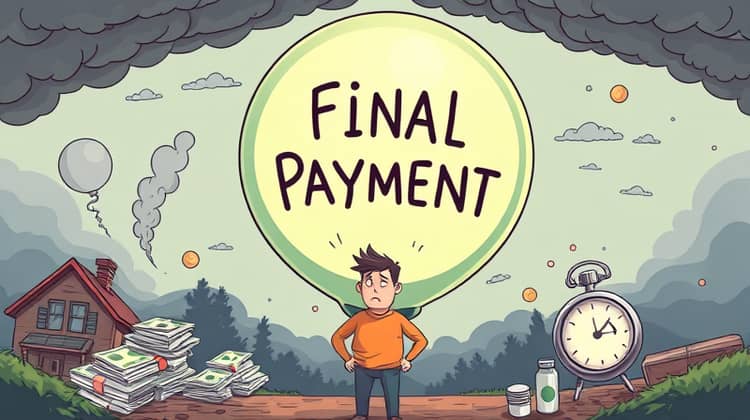Balloon Payments Explained: What You Need To Know Before Taking A Loan

In today's financial landscape, understanding various loan types is essential, particularly when considering options like balloon payments. A balloon payment represents a large final payment due at the end of a loan term after smaller, regular payments throughout the duration. This payment method can potentially ease monthly cash flow issues for borrowers but can also lead to financial strain if not managed properly. It is crucial for borrowers to understand the intricacies of balloon payments before committing to such a loan agreement.
Balloon payment loans can be particularly appealing to individuals or businesses that expect to improve their financial situation by the time the large payment is due. This can make it easier to manage the smaller intermediate payments while saving for the significant balloon payment. However, caution should be exercised, as not preparing adequately for this final payment can result in difficult financial circumstances.
Before you decide on a loan option, it’s beneficial to weigh the pros and cons, assess your financial stability, and evaluate your future earning potential. Balloon payments can provide lower rates and monthly payments during the loan term, but they can also lead to hefty dues at the end, which can cause financial hardship if not planned for effectively. Therefore, this article aims to shed light on balloon payments, guiding you through their definition, function, types, advantages, disadvantages, and best practices in managing them.
As you read, keep in mind that balloon payments may or may not be the right solution for you, depending on your financial goals and circumstances. Let's dive deeper into what balloon payments are and how they work.
What Is a Balloon Payment?

A balloon payment is a type of loan repayment structure where the borrower pays a significantly smaller amount in regular installments over the loan term, followed by a much larger 'balloon' payment at the end. It's essential to understand this setup, as it can impact your financial planning significantly.
Typically, balloon payments are found in loans with shorter durations, such as a five to seven-year loan where the remaining balance becomes due at the end of that term. This option is appealing for those who want lower monthly payments initially but should be approached with caution due to the eventual large payment responsibility.
Balloon payments can be used in various types of loans, including real estate financing and car loans. Borrowers should inquire if their lender offers such an option, comparing it against traditional loans that require consistent payments throughout the term.
It’s worth noting that the underlying principle is that the borrower may intend to refinance the loan before the balloon payment is due or expects an upgrade in income or asset value that will facilitate this payment.
How Balloon Payments Work

In the standard approach to a balloon payment loan, the borrower pays interest for a significant portion of the loan term and a principal that gradually reduces until the final payment, which settles the remaining principal balance. This structure can lead to significant savings in interest over time compared to traditional loans, making them attractive for some borrowers.
When the end of the loan term nears, borrowers face the challenge of preparing for this large payment. They may need to act ahead to manage their finances carefully. Being proactive about tracking their finances and preparing for the upcoming balloon payment can be crucial for avoiding potential pitfalls.
Another important aspect is the possibility of refinancing the balloon payment into a new loan. Many borrowers plan for this and will look for favorable refinancing terms near the end of their current loan agreement.
- Monthly payments are typically lower than traditional loans.
- The large balloon payment is due at the end of the loan term.
- Borrowers must plan financially for this large payment.
- Refinancing options may be available before the balloon payment is due.
In summary, understanding how balloon payments function is vital for successful financial planning and loan management. Borrowers need to be prepared for the payment they will eventually face.
Types of Loans with Balloon Payments

Balloon payments can be found in various loan types. Common examples include mortgages, auto loans, and certain business loans. Each of these loans may have specific terms related to how the balloon payment works, making it critical for borrowers to read the fine print and understand their obligations before committing.
Borrowers should ask lenders directly whether balloon payments are an option for the loan they are seeking. Loans might come with different structures, and being clear on the terms can prevent misunderstandings later.
- Residential mortgages with balloon options.
- Commercial property loans.
- Short-term financing solutions.
- Some auto loans may have balloon payments.
Choosing the right loan requires comprehensive understanding and evaluation of the available options, considering both the payment structure and personal financial circumstances.
Advantages of Balloon Payments

Balloon payments can provide financial flexibility for borrowers, allowing them to budget more effectively during the repayment period. With lower monthly payments, borrowers might find it easier to allocate funds to other important areas such as personal savings, investments, or paying off other debts. This can particularly benefit those expecting higher income or asset appreciation in the future.
Additionally, borrowers may save money on interest costs when choosing a loan with a balloon payment structure. Since the payments are lower initially, the interest over the loan term can often be less than that of a traditional loan.
- Lower monthly payments compared to traditional loans.
- Flexibility in cash flow and budgeting.
- Potential interest cost savings if planned correctly.
These advantages can make balloon payments an attractive option for certain borrowers, particularly those who have strategic financial plans in place.
Disadvantages of Balloon Payments

While balloon payments can be appealing, they also come with significant risks. The most concerning aspect is the potential for financial strain when it's time to make the balloon payment. Many borrowers may struggle to find the funds necessary to settle the substantial final amount, which can lead to added stress and financial difficulties.
Another issue is that if a borrower's financial situation does not improve as anticipated, they may be forced to refinance at unfavorable terms or risk defaulting on the loan altogether.
- Risk of not being able to make the balloon payment.
- Potential for higher interest rates on refinancing.
- Financial stress if circumstances change.
Awareness of these disadvantages is essential for making informed decisions when considering loans with balloon payment options.
Who Should Consider a Balloon Payment Loan?

Balloon payment loans may be suitable for individuals who anticipate a significant increase in income or cash assets in the near future. For example, a young professional starting a new high-paying job may find this option appealing, knowing they can manage the larger payment once their finances improve.
- Individuals with expected future income increases.
- Borrowers planning to sell an asset before the balloon payment is due.
- Those with strong financial discipline and planning.
However, these loans should be approached carefully and only by those who are well-prepared and have a solid plan for dealing with the balloon payment.
Tips for Managing a Balloon Payment

Managing a balloon payment effectively requires forethought and strategy. One of the first steps is to begin planning early for the large payment. Setting aside savings regularly throughout the loan term can help cushion the financial impact when the balloon payment is due.
Borrowers should also keep track of their financial situation and be aware of the market conditions, which can help them make informed decisions about refinancing or addressing the balloon payment.
- Start saving early for the balloon payment.
- Regularly review your financial situation.
- Explore refinancing options ahead of time.
- Consider consulting a financial advisor if needed.
By following these guidelines, borrowers can enhance their ability to manage balloon payments successfully, ultimately reducing financial stress during this payment phase.
Conclusion

In conclusion, balloon payments are a unique financial arrangement that can offer flexibility but also carry associated risks. Understanding how they operate, the various types available, and their pros and cons is crucial for anyone considering this option for financing.
By educating oneself on the dynamics of balloon payments, potential borrowers can better prepare for the challenges they may face. This education should include creating a solid financial plan that accommodates the eventual balloon payment and delving into loan specifics to avoid surprises.
Ultimately, each borrower must consider their circumstance and financial capability thoroughly before committing to a loan with a balloon payment structure.






